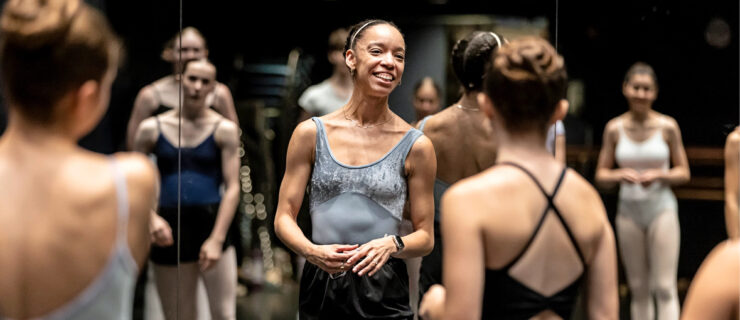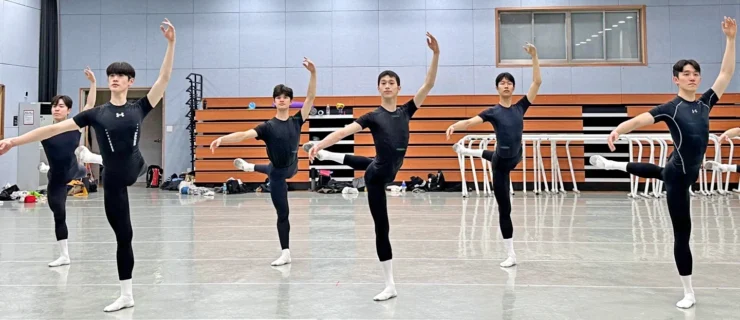Ask Amy: Embrace Your Curves
Have a question?
Click here to send it to Suzanne Farrell Ballet dancer Amy Brandt.
I am very self-conscious about my breast size, to the point where I always wear a T-shirt over my leotard. All the other girls at my studio are flat-chested. Any advice? —Britanny
Don’t feel embarrassed—if you look closely, you’ll find plenty of successful dancers who have bigger busts. You just need to learn how to work with it. Richmond Ballet’s Maggie Small, for instance, has tailored her leotard wardrobe to ensure adequate coverage and support. She avoids low-back camisoles, opting for shelf-lined zippered turtleneck and racer-back styles that allow her to wear a sports bra discreetly underneath. “There are a lot of form-fitting workout clothes, such as Under Armour, that fit like a leotard, too,” she says. Try revamping your wardrobe so you feel more comfortable.
But most importantly, be proud of your curves—I’d be willing to guess that your pancake-flat classmates are a little envious of you! Small, for one, doesn’t let her bustline bother her. “Learn to accept what you look like,” she says. “It’s one part of your whole package.”
I recently found out that my left hip is slightly higher than my right. Is this bad? What should I do to make sure it doesn’t affect my alignment? —Beth
Off-kilter hips may be a signal that one of your legs is longer than the other. According to Laura L. Ossowski, MSPT, a New York City physical therapist who works with dancers, leg-length discrepancies fall into two categories: functional and true. With a functional discrepancy, the leg bones are the same length, but the hips are misaligned due to postural habit. “For instance, a past foot or ankle injury will affect how you make contact with the ground,” says Ossowski. “You’re not at your most stable, so you compensate elsewhere.” A true leg-length discrepancy means exactly that: Your leg bones are literally not the same length. This discrepancy can manifest itself during puberty, especially if you suffered an injury during a growth spurt.
You’re right to feel concerned about your alignment. “A centimeter off is fine for the general public, but for a dancer, that’s huge,” says Ossowski. She recommends you seek treatment from a physical therapist to identify the cause of your hiked hip and help correct it. Depending on the diagnosis, your therapist can offer a specific exercise program to help you strengthen your core and other problem areas. “Whether it’s true or functional, you will be compensating—and compensation leads to inefficient movement, and that leads to injury.”
My dream is to be in a professional ballet company. I’m 17 and not sure where to start. Should I send out audition DVDs, look for second companies or consider traineeships? —Michaela
First, assess whether you’re technically and emotionally ready to enter the professional world—it’s competitive out there, and you’ll be held to higher standards. Since you lack experience, focus on auditioning for traineeships and second company positions—both serve as transitional periods between student and professional life. Traineeships tend to focus more heavily on classes and may require tuition, while second companies often pay a stipend. But keep an open mind: Many companies only offer one or the other. Check out our trainee listing on page 69, and scour company websites for additional info.
Ask yourself what type of company you’re most interested in (Balanchine? Contemporary? Mixed repertoire?) to narrow your focus. Determine whether directors look for dancers at open calls or during their school’s summer program (that’s how I got my start at the Milwaukee Ballet). Try not to limit yourself—if you can go to an audition, go!
If you’re not able to attend, send a DVD, cover letter, resumé, headshot and dance photos. Take some time preparing these—you don’t need to spend a fortune, but go the extra mile (clean video editing, higher-grade paper, writing free of spelling and grammatical errors) to show you are serious and professional. Keep your DVD to 10 minutes max. In addition to hard copies, post a version online and include the link on your resumé. Finally, follow up! Companies are often swamped with audition materials—no response could just mean that they haven’t gotten around to looking at yours yet.





